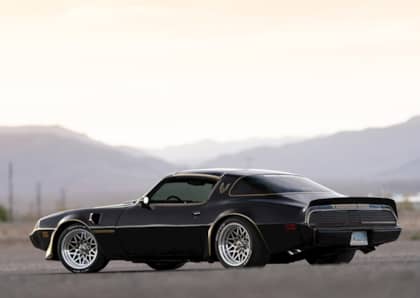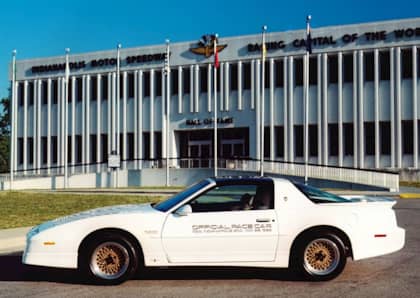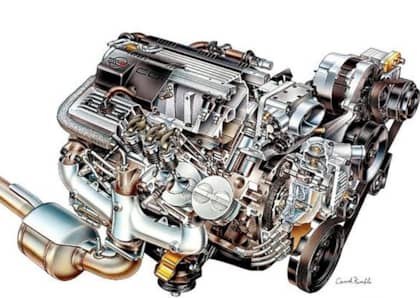The Turbo Trans Am Was Pontiac's Ahead-Of-Its-Time '80s Muscle Car
GM's history of its reach exceeding its grasp was never more apparent at the beginning of the 1980s. This was the era that would bring forth stumbles like the Chevrolet Citation and its X-body brethren and the Oldsmobile diesel as the company tried its best to execute technologies that clearly weren't ready for prime time.

For muscle car fans, the 1980-81 Pontiac Trans Am Turbo is the most famous example of the engineering optimism so pervasive at General Motors. Flush with Buick's success at building a peppy, relatively frugal turbocharged V6 for the Regal, the Century, and the Riviera, Pontiac made the decision to bring a pair of extra cylinders to the boost party and shake off some of the high performance stagnation that had taken root in the company's showrooms.

Photo courtesy of Elana Scherr.
The end result was the Pontiac 301 Turbo V8, one of the least desirable Trans Am motors ever produced, and a drivetrain that has become something of a '80s muscle car cult figure among those faithful to the now-defunct brand.
Turbo Of Last Resort
Why go turbo? The culprit was the death of the big block, which was pulled from production after nearly a decade of service under the hood of the Trans Am and Firebird due to the grim forecast for energy costs at the end of the 1970s. The cupboards were bare when it came to muscle at Pontiac, which was left with the wimpy base 301 cubic-inch V8 as its sole drivetrain choice.

The options were to go begging from other GM divisions for something mightier (such as a 5.7L from in-house rivals Chevrolet), abandon the Tran Am as a true muscle car and instead orient it towards the grand touring crowd, or get innovative using advanced experimental designs that may or may not have been completely understood by the development team.

Pontiac chose door number three, which meant whipping up a carbureted turbo version of the 301 and hoping for the best with the 1980 Turbo Trans Am. The recipe included a reduced compression, thicker-block version of the V8, stronger engine internals, a four-barrel carburetor, a hottish camshaft, and 9 lbs of boost from a single turbocharger. A three-speed automatic transmission was included with every car, and the entire Turbo option was priced cheap (about $350 over a base Trans Am) to help lure in curious customers. Also serving to entice prospective buyers was the world's coolest boost gauge mounted in a hood pod labeled 'TURBO CHARGE' directly in front of the driver.
Where's The Beef?
On paper, it was an upgrade over the standard 301 (which was really a 302 that marketing had rounded down to prevent confusion with Ford's popular small block V8). With the entry-level Firebird delivering 155 horsepower or so, the Trans Am Turbo promised 210, which also looked to be within spitting distance of the 220 horses provided by 1979's now-departed 400 cubic inch big block.

In reality Pontiac had fudged the numbers of its departing 400 CID, which was more realistically producing over 260 horsepower and reams more torque than the 301 Turbo's 345 lb-ft. This became quite clear when the Firebird Trans Am Turbo hit the drag strip and turned in a quarter mile time in the mid-16 second range, which was nearly 1.5 seconds slower than its predecessor. If one opted for the Firebird Formula Turbo, which was the stripped down alternative to the Trans Am, a few tenths of a second of extra daylight opened up between the two cars. Fully-loaded Indy 500 Pace Car replicas were the most languid, and most expensive, of all Trans Am Turbos with their T-tops and long list of options

That the Turbo Trans Am was slow—in fact, frequently bested by manual 5.7L Camaros—was only part of the problem. A bigger issue was the turbocharged setup itself causing no end of hassle to owners frustrated by its frequent ignition issues. The poorly-tuned computer-controlled setup was over-protective of the 301's innards to the point where it regularly pulled spark to prevent detonation, especially when faced with common low-octane fuel. Even this hyper-vigilance wasn't enough, as the primitive turbo carburetor often couldn't stuff enough air and fuel inside the motor to prevent pre-ignition and pinging in the best of conditions.
The End Of Pontiac's Independence
Although the Trans Am Turbo would continue to sell, by the end of the year only 20 percent of production carried the Garret turbocharger under the hood, with total Trans Am sales having been cut by 50 percent compared to the last year of the big block. In 1980 Pontiac would try a computerized carburetor that turned out to be no better than the original setup at enhancing the 301's performance, and sales would be sliced in half yet again.

It was a humbling experience that set Pontiac's drivetrain department back on its heels and forced it to accept a 5.7L V8 from Chevrolet when the Firebird was redesigned for 1982. In a way, the Trans Am Turbo represented the beginning of the end of Pontiac's independence from the GM mothership, as the car would, with a few minor deviations (such as the return of the Turbo in the form of 1989's Buick-based, 3.8L V6 20th Anniversary Edition car) copy the Chevrolet Camaro's mechanicals for the rest of its existence.
More From Driving Line
- Buick's high performance turbo cars were much more successful than Pontiac's. Check out this history of the Buick 3.8-liter V8, GM's mightiest '80s muscle car motor.











